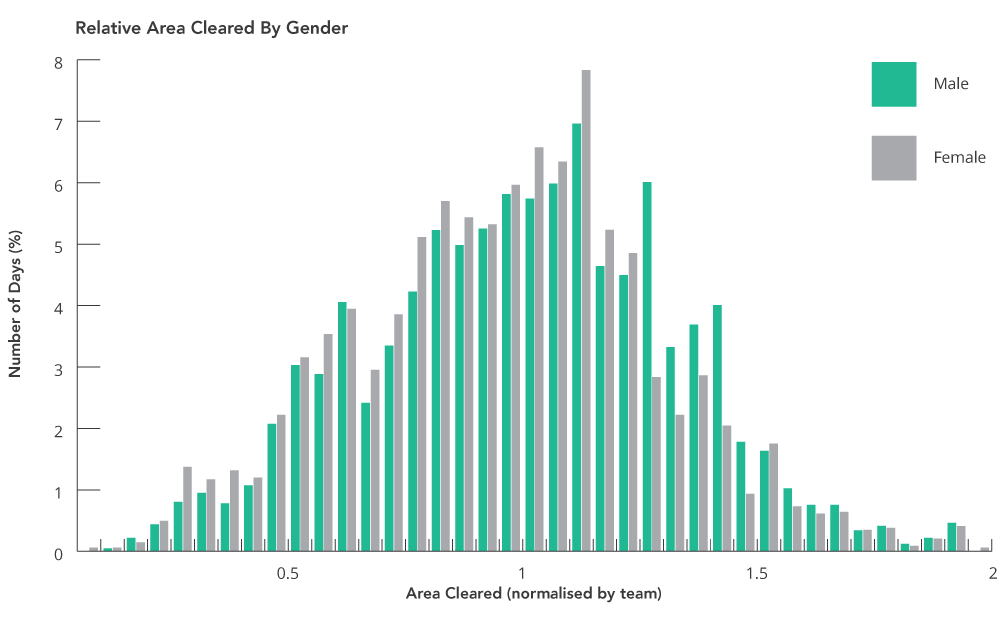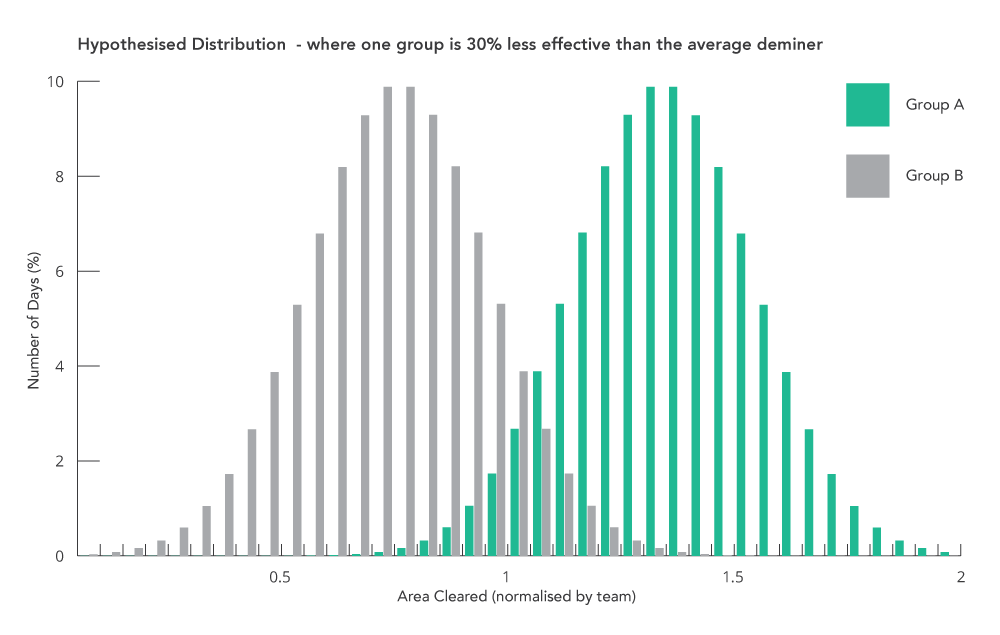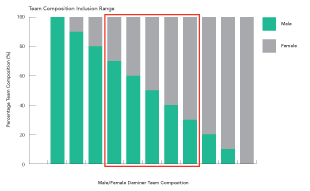Gender and Operational Efficiency
By Raphaela Lark, David Hewitson [ Fenix Insight Ltd ], and Dominic Wolsey [ Geneva International Centre for Humanitarian Demining ]
CISR JournalThis article is brought to you by the Center for International Stabilization and Recovery (CISR) from issue 26.1 & 2 of The Journal of Conventional Weapons Destruction available on the JMU Scholarly Commons and Issuu.com
This study explores the relationship between gender and operational efficiency in the context of staff in field-based mine action roles. The aim of the study is to address stereotypes and unproven assumptions that may still exist in the mine action sector regarding women’s performance and availability to work in certain field-based roles. Operational efficiency was investigated using two key indicators: individual operational productivity and availability to work. Operational and human resource data was collected from fourteen country programs from four separate mine action organizations across four continents. A quantitative analysis of the data found no meaningful difference in operational productivity or availability to work in field-based roles in mine action based on gender.
Introduction
The participation of women in mine action activities has increased substantially over the last decade. Mines Action Canada conducted a study which collated data from twelve operators in 2019 showing that globally, around 20 percent of mine action staff are women.1 However, there is still a long way to go to increase gender balance in mine action in line with the Women, Peace, and Security (WPS) Agenda’s participation call and Sustainable Development Goal 5.2 In the same study published by Mines Action Canada, gender balance was described as “significantly better” in headquarters, finance, and administrative roles as opposed to clearance roles.3 This is in line with other research, which points toward clearance as being the most male-dominated pillar of mine action.4
Stereotypes and unproven assumptions about women’s performance and availability in certain field-based roles persist in some parts of the sector. Arguments are made about women’s physical strength relative to men, slower clearance, or time taken off work, which are then cited as potential downsides to the recruitment of women in deminer or searcher roles. It is sometimes assumed that women in the mine action sector take more time off because of maternity leave or other caregiving responsibilities. These claims limit progress toward increasing women’s access to employment in mine action. Furthermore, although anecdotal, evidence indicates increasing global recognition that employing women can be beneficial to land release activities, data has not yet been formally analyzed to investigate this until now. This study aims to address this gap by exploring the relationship between gender and operational efficiency in the context of field-based staff.5
Defining Operational Efficiency
Efficiency is generally defined as the ratio between the level of effort put into an activity or process and the level of output generated by that activity or process.6 For the purposes of this study, the process of interest is the one in which the threat of mines or other explosive ordnance (EO) in a hazard area is reduced to an acceptable level through technical survey or clearance activities. More specifically, this study looks at whether there is any difference in the performance of men and women in implementing technical survey and clearance activities that rely on human effort, such as the use of detectors, locators, excavation, and raking methods.
The output of the land release process is “land” usually measured in square meters. The input effort is measured in the amount of time spent by the deminers engaged in clearing that area.7 One of the most common indicators used to measure human performance in land release work is m2/deminer/day. The indicator is itself a measure of efficiency—m2 is the output; a deminer-day is a measure of input effort. A deminer who consistently delivers a higher number of m2/day can be said to be more efficient than another who delivers less output in the same amount of time.
It is important to recognize that the speed with which land is checked can be one measure of success, but it is more important that such land is clear of explosive hazards. A deminer who clears land quickly but misses threat items would be failing to meet basic quality requirements. While such a statement is obvious and important, it should also be noted that it is uncommon for such a situation to arise in most mine action organizations. Each square meter is re-checked, often more than once, as part of internal supervisory and quality management processes. It is also important that the rate of progress is not prioritized over the safety of deminers. The organizations providing data for this study are all recognized as meeting international standards, including applying rigorous internal quality and safety checking procedures. For the purposes of this study, it was assumed that the square meters reported in the provided data met quality requirements.
There are many dimensions of efficiency that can be investigated, including those relating to cost. This study has not attempted to disentangle the many facets of direct and indirect cost and the allocation of those costs to mine action operations. This is partly because of the difficulty in doing so, and in obtaining agreement among operators on these questions, but more so because any analysis of efficiency in relation to survey and clearance must, at its base, engage with the issue of practical productivity. If one deminer clears more land faster than another, for a similar cost, then they must be more cost efficient. By focusing on this fundamental aspect of operational efficiency, the results of this study will inform other researchers who may wish to engage more fully with economic or social aspects of the employment of men and women.
In terms of output, the more deminers are available, and the more days of effort they deliver, the greater the total area of land that they will deliver. In simple arithmetical terms, the fundamental production relationship can be described as:
Production (P) = Number of productive resources (N) x
Unit productivity (U) x Working time (T)
For there to be a difference in the productive output of one deminer (N = 1) compared with another, one deminer would have to either deliver higher productivity (U) within a similar time to the other or be available to work for more time (T) at a similar level of productivity, or a combination of the two. This study investigates both factors—whether there is any evidence to suggest that there is a difference in individual productivity between men and women, and whether there is any difference in the availability to work between men and women. To do so the project focused on two key indicators: 1) daily output measured in m2 and 2) the proportion of workdays available for work, both of which are routinely measured, recorded, and reported by mine action operators (MAOs).
The two research questions that were addressed were:
Research Question (RQ) 1: Is there a difference in operational productivity between men and women?
Research Question (RQ) 2: Is there a difference in availability to work between men and women?
General Management of the Study
The study was managed in three phases. The first phase consisted of interviews with MAOs to establish their willingness to participate in the study and the likely availability of suitable data. Interviews were conducted with nine women and thirteen men from six different MAOs. Sample data was requested from participating organizations and initial analysis was carried out to improve understanding of the suitability and limitations of the available data, and to refine the study inclusion criteria and analysis methods. It was agreed that all operational data would be anonymized to maintain the confidentiality of MAOs, programs, and personnel.
The second phase consisted of the main data collection activity: re-engaging with participating MAOs to define the required characteristics of study data, to obtain the data, and to follow up with questions about any aspects of the data that were not clear. Data was collected from fourteen country programs from four separate MAOs. These country programs are situated in eleven countries spanning the Middle East and North Africa (MENA) region, Africa, Latin America, Asia, and Europe.
The final phase of the study involved analysis of the data that met the inclusion criteria, review of the results, and preparation of this report. The methodology for this study, including inclusion criteria for the data, is set out in detail in an annex available at the end of this article.
Research Question 1: Is there a difference in operational productivity between men and women?
By comparing the operational productivity of women and men at a deminer level, the first research question looks at U, the rate at which product is produced (usually known as “productivity”). Operational data from six country programs satisfied the inclusion criteria which considered differences between tasks, team composition, and minimum number of days worked.8 Clearance methodologies include one deminer one lane (ODOL) with detector, sub-surface battle area clearance (BAC), and other mixed excavation and detection approaches. Within the data, twenty-three teams from six country programs yielded a total of 7,575 “person-day” values that met the inclusion criteria.
Findings
Figure 1 displays the proportional clearance performance by gender. The productivity of each day is shown as a ratio of the average cleared area in a day per team. Subsequently, a result of 0.5 indicates that an individual deminer, on that day, at that site, produced fifty percent of the average output per deminer achieved by the mixed team on that day. Collation of the 7,575 person-day results that met the study inclusion criteria resulted in the distribution shown in Figure 3 (see annex). The x axis corresponds to the normalized performance.9 The y axis represents the frequency of occurrence of this value as a percentage of the overall dataset of person-days.

Figure 1: Percentage of days per gender by area cleared (normalized by team). The performance results for men and women approximate to a normal distribution curve in both cases (women: μ= 0.970, σ = 0.367; men: μ= 1.028, σ = 0.401). The difference between means (μ) is negligible, indicating that there is no meaningful difference in operational productivity by deminer based on gender. All graphics courtesy of the authors.
For comparison, Figure 2 shows how the distribution would look if one group were performing at thirty percent less than the average deminer and the other at thirty percent above the average.

Figure 2: Illustrative histogram of the result should one group be thirty percent less effective than the average deminer. The data for Group A follows a normal distribution with (μ= 0,7, σ = 0.2), for Group B the parameters are (μ= 1,3, σ = 0.2).
In Figure 1, the central portions of the curve (between 0.75 and 1.25 times the average) results for women are slightly higher than for men, but a small number of results between 1.25 and 1.5 times average, show a higher figure for men than women. Such variations are associated with a small number of sites and days when other external factors, that were not indicated in the records, may have been influential. Expansion of the analysis to more data meeting the inclusion criteria would be expected to bring the curves for both men and women closer to the underlying normal distribution already evident in Figure 1. There is no general pattern which suggests that operational productivity varies significantly between genders.
| Country | Gender index11 | Women deminers | Men deminers | Total | % Women | Months of data | Year |
| A | Low | 140 | 187 | 327 | 43% | 12 | 2019 |
| B | High | 129 | 202 | 33 | 395 | 9 | 2021 |
| C | Very high | 36 | 135 | 171 | 21% | 5 | 2021 |
| D | Very high | 36 | 151 | 187 | 19% | 12 | 2021 |
| E | Low | 20 | 69 | 89 | 22% | 12 | 2021 |
Conclusion
The analysis indicates that within the study parameters there is no meaningful difference in terms of operational productivity between men and women working in technical survey and clearance. Both women and men are represented at the upper, most productive, and lower, least productive ends of the range, with no meaningful difference in distribution.
Research Question 2: Is there a difference in availability to work between men and women?
The second research question explores T (the working time variable using HR data). Table 1 represents a summary of the data collected. The table includes the OECD Social Institutions & Gender Index for each country as contextual information.10 Notably, data was collected from countries with scores ranging from low to very high in the index.
Data Analysis
To conduct cross-comparison between country programs, leave types were grouped into larger categories: compulsory, sick, and parental leave, while other types were grouped into one remaining category (“other”). This ensured that only those leave types that were common across all datasets, such as sick and parental leave, were compared against each other.
Compulsory leave encompasses annual and compensatory leave as it is time taken off that is required by operators. Sick leave data was available in all five datasets. Parental leave data, which includes maternity and paternity leave, were available in four datasets (A, B, D, and E). Finally, all other types of leave which did not necessarily have an equivalent across country programs were grouped into the remaining “other” category.
The analysis therefore focused on sick, parental, and “other” categories of leave. Three sub-questions were explored in the analysis:
What is the average time taken off for sick
leave per deminer by gender?
What is the average time taken off for
parental leave per deminer by gender?
What is the average time taken off per deminer by gender when excluding parental and compulsory leave?
Country program C was excluded from the analysis in sub-questions two and three as the dataset only contained information on sick leave. Datasets relating to country programs B and C included data over a period of nine and five months, respectively, whereas country programs A, D, and E were collected over a period of twelve months. To compare them the results displayed in tables two and four were normalized to reflect the average time taken off over a period of a year.
Findings
Average time taken off for sick leave. The first sub-question looked at the average sick leave taken by gender. In country programs B, C, D, and E the annualized difference between men and women is a few hours. While noting that in country program A women take two and a half days more sick leave than men over that year, there is no general pattern across the different countries that indicates that there is a meaningful difference between men and women in time taken for sick leave. It is also worth noting that the total number of days of sick leave taken is generally very low in comparison to the typical working year of around 220 days.12
| Country | Average per woman per year |
Average per men per year |
Difference (in days) |
| A | 9.2 | 6.7 | 2.5 |
| B | 2.9 | 3.1 | -0.2 |
| C | 0.4 | 0.5 | -0.2 |
| D | 3.9 | 3.6 | 0.3 |
| E | 4.4 | 4.5 | -0.1 |
| Table 2. Average time taken off for sick leave. | |||
Parental leave. The second sub-question looks at the percentage of deminers taking parental—maternity and paternity—leave per country program. The average time taken off for parental leave is also calculated.
Analysis indicates that in country program A, ninety-six percent of women did not take maternity leave in the time frame for which data was collected, similarly that percentage was ninety-two percent for country D, and 100 percent for country E. Among those women who took maternity leave, an average time of sixty-five days for country program A and forty-four days for country program D were taken. Paternity leave was not taken by deminers in country program A and E. In country program D, five percent of deminers took paternity leave for an average time of two days.
Overall, the number of deminers who take parental leave is small. The results indicate that maternity leave is taken by a very small proportion of women deminers in a year.
| Country | Average per women | Average per men | Difference (in days) |
| A | 3.5 | 2.6 | 0.9 |
| B | 9 | 10.4 | -1.4 |
| D | 5.6 | 5.4 | 0.2 |
| E | 7.7 | 7.8 | -0.1 |
| Table 4. Average time taken off excluding parental and compulsory leave. | |||
Average time taken off. Sub-question three looks at the average time taken off when excluding parental and compulsory leave. Country program B shows women taking on average one leave day less than men, while in country program A the opposite is true, women take on average one day more. In country programs E and D, the difference is measured in hours rather than days. Overall, in all four country programs the results indicate that there is no meaningful difference between men and women in time taken off.
| Staff who took parental leave per gender (%) | Average days taken for staff who took parental leave | |||
| Country | Women | Men | Women | Men |
| A | 4% | 0% | 64.7% | 0 |
| D | 8% | 5% | 44 | 2.1 |
| E | 0% | 0% | 0 | 0 |
| Table 3. Deminers (percentage) who took parental leave including average time taken off. | ||||
Conclusion
The analysis indicates that there is no meaningful difference in availability to work between men and women employed in field-based roles. In particular, the findings suggest that women and men take roughly equal sick leave and general leave from work. These findings also suggest that maternity leave is taken by only a small proportion of women deminers and paternal leave by a very small number of deminers and only for short periods.
Recommendations for Future Research
Gender inequality in the country programs analyzed are ranked from low to very high, but this difference in contextual reality is not reflected in the findings. Considering the difference in gender index scores, it is likely that across the country programs analyzed, the degree to which women will have additional burdens—such as unpaid care and housekeeping chores—may differ from men. This observation raises several questions related to women’s experience in the mine action sector which may merit investigation in further research.
Final Remarks
This study explored the relationship between operational efficiency and gender. It did so by looking at the rate at which product is produced (U) and working time (T). For there to be a difference in operational efficiency, there would have to be a difference in either operational productivity or available time to work, or both.
The findings indicate:
- no meaningful difference in operational productivity (U) based on gender;
- no meaningful difference in availability to work (T) based on gender.
Annex – Methodology
This annex details the methodology adopted throughout the study. It outlines how the data was collected and analyzed for each research question.
Data Collection & Generalizability
A purposive sampling method was used to collect data for the two research questions, meaning that operators and country programs were deliberately approached.13 This method reflects the realities of collecting data in the mine action sector whereby it is necessary to first build a rapport with relevant operators and second to determine what data they collect and what they can share. Although the findings cannot, in strict statistical terms, be generalized to the whole population of deminers working around the world, it is reasonable to conclude that on the basis of the wide breadth of data collected from fourteen country programs and four distinct operators, the findings are indicative for the entire mine action sector.
Research Question 1: Data selection Comparing ‘like-for-like’
Like most human endeavors, mine action, especially survey and clearance, is complicated and often complex.14 Easily defined activities, such as searching ground for EO hazards, take place within a wider context of interacting physical, economic, social, and professional influences. Defining those influences can often be difficult and developing mechanisms to describe their interactions is even more challenging. The mine action sector continues to devote time and effort to developing common methods for documenting and analyzing factors such as ground, topography, vegetation, weather, and security, but effective systems are not yet fully agreed upon or implemented. Other factors, such as management decision-making, including the influences of prejudices, assumptions, misconceptions, and other perceptions, may also influence the conduct of survey and clearance by deminers.
The breadth and uncertainty of contextual aspects meant that any analysis seeking to compare performance between individuals in different survey and clearance teams, working at different locations, would have suffered from distortion by too many external factors that could not be normalized. These factors are considered external variables which, if not controlled for, could affect the measurement of the independent variable, gender. Due to the nature of clearance, it is difficult to fully control these external variables, but it is possible to mitigate against them.
In the absence of either enough contextual data, or any agreed method to normalize performance within such data, the study team ensured that performance comparisons satisfied “like-for-like” requirements as much as possible. Comparison between men and women was conducted for deminers within the same team working on the same task on the same days over an extended period. Doing so minimized the influences of decision-making managers and the physical environment by ensuring that any comparisons were made within a team context that would be subject to the same group of influences at the site, and on the day, when working data was recorded. It is recognized that, even on one work site, different clearance lanes can be subject to very different physical factors, including slope, vegetation, contamination, etc., but by imposing a minimum number of days of data for each team, the effects of such factors on individual performance are more likely to even out.
While collecting data, special attention was given to what type of clearance methodology was used by a deminer on a particular day. In the rare instances where deminers from the same team were working according to different methods of clearance, only those values that were from the same clearance methodology were compared. This ensured that values were compared on a “like-for-like” basis.
Inclusion Criteria for Data Selection
When analyzing issues relating to gender, it is important to take into consideration societal factors. For instance, a team leader may treat women and men differently, which could in turn influence their outputs. By selecting teams where women and men are evenly split (or close to), the study mitigated against some of those societal factors.
An inclusion range was developed to ensure that the averages calculated were as representative as possible. Ensuring that there was a balanced number of women and men in the team analyzed increased the chances that the results were not explainable by chance alone. This inclusion range was a minimum of thirty percent women or men deminers per team. Any mixed teams with fewer than thirty percent men or women deminers were excluded from the analysis. This percentage did not include the team leader as they did not have square meters cleared associated to their name.
Teams with fewer than twenty values (person-days) on average per deminer were also excluded. A value represents the total m2 cleared in one day by one deminer. This inclusion criterion was developed to ensure that the values collected per deminer were as representative as possible of their “normal” performance. A low number of values are more likely to be susceptible to the effects of external factors such as differences in terrain between deminers or how the deminer was feeling on that specific day. By including teams with a minimum average of twenty days per deminer, the likelihood of strong fluctuation decreases.
Operational data from six country programs satisfied the inclusion criteria. Clearance methodologies included ODOL with detector, sub-surface BAC and other mixed excavation and detection approaches. All clearance methods were included in the analysis if it was possible to determine which square meters were cleared by which deminer. Within the data, twenty-three teams from six country programs each from different geographical regions yielded a total of 7,575 ‘person-day’ values that met the inclusion criteria. On average, within the data collected, teams were composed of forty-five percent women and data were extracted over an average period of thirty-six days per team.
Data Analysis

Figure 3. Inclusion range for composition of mixed teams.
The data was normalized per team to combine the data from all twenty-three teams. Normalization means adjusting the values measured on different scales to a common proportional scale to be able to compare their distribution. Each daily value for individuals within a specific team was ratioed to the average value for that team across all data for that team, with the team average equaling one. To do so the following equation was used:
normalised data=data/( average m2 cleared ).
The average output per deminer for each team equates to one. The output values associated with each deminer on that day at that site were ratioed against the average output per day to yield a spread of productivity disaggregated by gender. In this way all values within the dataset become a ratio of the average performance per deminer per day for their team. The results are displayed in the form of a histogram. The x axis corresponds to the proportional area cleared (normalized by team). The y axis represents the frequency of this value as a percentage of the overall dataset (i.e., the percentage of the overall dataset of 7,575 person-days).
Figure 2 shows how the distribution would look if one group were performing at thirty percent less than the average deminer and the other at thirty percent above the average. The data for Group A follows a normal distribution with (μ= 0,7, σ = 0.2) and for Group B the parameters are (μ= 1,3, σ = 0.2).
The performance results for men and women approximate to a normal distribution curve in both cases (women: μ= 0.970, σ = 0.367; men: μ= 1.028, σ = 0.401). The difference between means (μ) is negligible, indicating that there is no meaningful difference in operational productivity by deminer based on gender.
The analysis draws from 7,575 data points of which 4,135 are days worked by men and 3,440 by women. The histogram is separated into forty bins of a width of 0.05 and range from zero to two. Although outliers with values above two are included in the analysis, these are not displayed in the figure as they do not affect the results and are not helpful in visualizing the general pattern which emerges.
Research Question 2: Data Selection
HR data relating to leave days was collected for all operational/technical staff within a country program across a total of five countries and spanning over three continents.15 Operational/technical staff included those who were engaged in community liaison (CL), explosive ordnance risk education (EORE), and survey and clearance. As opposed to RQ1, HR data was not only collected for deminers but for all field staff, as they are likely to experience similar influences relating to leave including management practices, program policies, and societal factors. An added benefit of expanding the inclusion criteria to all field-based staff was that larger datasets could be included in the analysis. Senior management and office-based support staff were not included in this analysis, as different leave policies and practices apply to field-based and office-based staff. It was not necessary to look at HR data on a team basis as the study did not need to mitigate for differences relating to the type of minefield or task.
The datasets were collected in a way which minimized the impact of the COVID-19 pandemic on the data. The pandemic, which started in 2019 and is still ongoing at the time of writing, may have affected leave days taken by operational staff as they were forced to quarantine if they either contracted the virus, displayed symptoms, or were in contact with someone who tested positive. Two approaches were used to minimize the effects of the pandemic on the datasets: (1) talking to country programs to understand in what way the pandemic had affected their operations and collect data from those years where they had been least affected, and (2) excluding leave days relating to COVID-19 when this was possible to do so, i.e., the country program differentiated leave days taken because of COVID-19 from other types of leave (including sick leave for other reasons).
Data Analysis
The dataset sample grouped five country programs and included a total of 1,105 individuals, 361 of which were women. Availability was measured by calculating the average “unavailable” time for men and women within operational/technical staff per country program.
availability to work=(total time off)/(number of deminers).
Categories of leave across operators and country programs were not necessarily equivalent or measured in the same way. Some datasets were more detailed, with eight categories of leave specified including COVID-19 and accident leave, while others only included sick leave. Although categories may have a similar heading, it is not guaranteed that the definition of that category is identical in all country programs. For instance, several operators record compassionate leave, but this may be measured differently in various country programs.
To conduct cross-comparison between country programs, leave types were grouped into larger categories: compulsory, sick, and parental leave, while other types were grouped into one remaining category (“other”). This ensured that only those leave types that were common across all datasets such as sick leave and parental leave were compared against each other.
Compulsory leave encompasses annual and compensatory leave as it is time taken off that is required by operators. Sick leave data was available in all five datasets. Parental leave data, which includes maternity and paternity leave, were available in four datasets (A, B, D, and E). Finally, all other types of leave, which did not necessarily have an equivalent across country programs, were grouped into the remaining “other” category.
The analysis therefore focused on sick, parental, and “other” categories of leave.
 Raphaela Lark
Raphaela Lark
Project Officer
Fenix Insight Ltd.
Raphaela Lark graduated with a bachelor’s degree in International Relations from Durham University in 2018 and is completing a research master’s degree in Urban Studies at the University of Amsterdam. She currently works as a Project Officer at Fenix Insight Ltd.
 David Hewitson
David Hewitson
Director
Fenix Insight Ltd.
David Hewitson has been working in mine action for over thirty years. He conducted practical clearance of landmines in Afghanistan, Cambodia, Mozambique, and Angola and established and managed field programs. In 1995 he founded a commercial demining company and employed more than 3,000 people in projects all over the world. For the last ten years he has worked as a founder and director at Fenix Insight Ltd. Throughout his mine action career, he has emphasized the importance of the collection and analysis of data to support valid and effective decision-making, including in the field of operational performance and, more generally, understanding the reality, rather than perception, of risk. Before joining the mine action sector, he served in surface ships and submarines in the Royal Navy. Hewitson has a degree in Aeronautical and Astronautical Engineering.
 Dominic Wolsey
Dominic Wolsey
Advisor
GICHD
Dominic Wolsey is an Advisor with the Geneva International Centre for Humanitarian Demining’s Gender Mine Action Programme. He works on gender and diversity mainstreaming through capacity development, technical assistance, research, and international and national policy work. He holds an MSc in Global Politics from the London School of Economics and Political Science and a BA in History from University College London.

